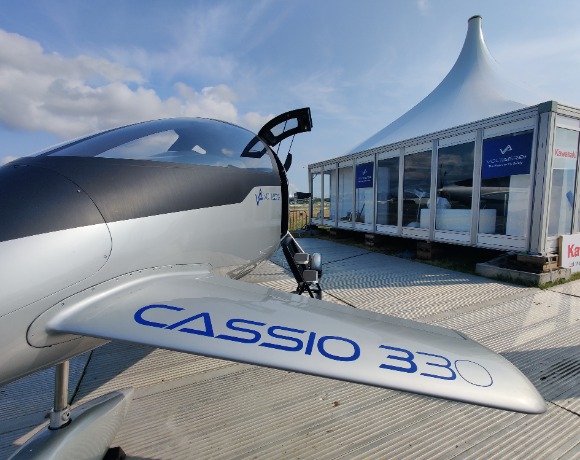Ishka recorded a total of 71 new propulsion product commitments during the Farnborough Airshow week, with over half (82 engines equivalent to 41 aircraft conversions) coming from hydrogen-electric propulsion OEM ZeroAvia and the rest split between hydrogen-electric amphibious aircraft developer Jekta (14), and hybrid-electric aircraft manufacturer VoltAero (16). Ishka also included in the tally an LOI for an unspecified number of Elfly’s Noemi zero-emission amphibious aircraft signed the week before the airshow. These additions take the year-to-date new propulsion commitment tally to 681 and bolster the percentage share of firm orders from 4.4% pre-Farnborough to 10.1% so far this year (27 to 69 firm aircraft orders or powertrain equivalents, options included).
In the last New Propulsion round-up in early July, which covered announcements in the first half of 2024, Ishka noted a slowdown in commitments, particularly firm orders. To make up the difference to 2023, the Farnborough week had to deliver around 300 new commitments (firm or LOIs). Instead, it delivered 71 new total commitments, significantly below that number and consequently the 2024 post-Farnborough tally (681) remains below the H1 2023 tally including the Paris Air Show (862).
Nevertheless, in addition to the rebound of firm orders (+42), there appears to be encouraging momentum in the smaller end of the market, with 16 out of 23 new propulsion deals recorded by Ishka in 2024 concerning aircraft carrying less than 20 passengers.
Six announcements, 30 aircraft, and 82 powertrains
| OEM | Product | Feedstock aircraft (if applicable) | Customer | MOU/LOI | Firm | Total |
|---|---|---|---|---|---|---|
| ZeroAvia | ZA2000 | DHC Dash 8 / ATR42 and ATR72 | Ecojet | 0 | 11+20 | 31 |
| VoltAero | Cassio 330 | N/A | Sigma Air Mobility | 0 | 1 | 1 |
| Jekta | PHA-ZE 100 | N/A | Seaplane Asia | 14 | 0 | 14 |
| ZeroAvia | ZA2000 | DHC Dash 8 / ATR42 and ATR72 | ASL Aviation Holdings | 0 | 10 | 10 |
| VoltAero | Undetermined | N/A | Global Sky | 15 | 0 | 15 |
| Elfly | Noemi | N/A | Region of Gotland | 0 | 0 | 0 |
| Total | ||||||
| Source: SAVi New Propulsion Tracker, company announcementsNote: ZeroAvia commitments announced as number of engines (62 and 20 respectively), divided in half (two engines per aircraft) for aircraft-equivalent commitments | ||||||
Deal details:
- Elfly & Gotland Sweden: Announced the week before the Farnborough Airshow, with this LoI the parties aim to explore “deeper cooperation.” The LoI does not specify intent to purchase Elfly’s Noemi nine-seater all-electric amphibious aircraft, but the municipality of Gotland has been actively exploring electric flight options, also entering into a partnership with Heart Aerospace on 27th July (though this announcement makes no mention of aircraft LoIs).
- Jekta & Seaplane Asia: An agreement for the purchase of 14 amphibious 19-seater PHA-ZE 100 aircraft. Seaplane Asia is working to set up several operators throughout Southeast Asia focused on very short distance flights (airport to waterfront, sightseeing, island to island…).
- VoltAero & Sigma Air Mobility: No number of committed aircraft was discussed at this stage, but during a press briefing attended by Ishka on 24th July, Sigma Air said it intends to take delivery of one Cassio 330 in 2026 to "identify markets and test" the aircraft before deciding on the final fleet commitment. If all goes well, there could be potential for a commitment of "a few hundred aircraft” – product choices not specified.
- VoltAero & Global Sky: MoU for the pre-order of 15 Cassio aircraft (type not specified), making the lessor a candidate launch customer in Southeast Asia for VoltAero’s electric-hybrid aircraft.
- ZeroAvia & Ecojet: Twenty-two firm orders for ZeroAvia’s ZA2000 hydrogen-electric engines (equivalent to 11 aircraft conversions), with options for a further 40 engines (equivalent to 20 aircraft conversions). The deal builds on a previous agreement made in November 2023 where Ecojet, a prospective airline based in Edinburgh and hoping to be the world’s first fully electric airline, had signed an agreement for up to 70 hydrogen-electric engines. This deal is understood to establish a deposit schedule to secure early production slots.
- ZeroAvia & ASL Aviation Holding: Commitment to paying deposits to secure delivery slots for 10 engines (equivalent to five aircraft conversions), with a further option for up to another 10 (equivalent to another five aircraft conversions). The deal builds on a previous partnership agreement announced in November 2021 aimed at converting up to 10 of ASL’s owned ATR72 freighter aircraft to hydrogen-electric propulsion.
Boots (and some wheels) on the ground at Farnborough
The number of new propulsion OEMs exhibiting at Farnborough 2024 was comparable to the 2023 Paris Air Show. It included Cranfield Aerospace Solutions (CAeS), Deutsche Aircraft, Dovetail Electric Aviation, Heart Aerospace, Jekta, VoltAero, ZeroAvia and Fokker Next Gen. A number of supply chain firms including powertrain developers (Nidec, Verdego) were also present. Across the fixed-wing new propulsion OEMs, the only firm with a full-sized aircraft mock-up was VoltAero with its Cassio 330 (pictured at the start of this report). This was, once again, in stark contrast to the contingent of e-VTOL firms.
Although seemingly present in smaller numbers, with much smaller floorspace than at the 2023 Paris Air Show, and without performing demonstration flights, e-VTOL firms received significant attention by unveiling new prototypes. They included Vertical Aerospace’s latest VX4 ahead of flight testing, Supernal debuting its S-A2 concept, Joby’s model making its European debut, and Eve unveiling its initial e-VTOL prototype at its parent’s Embraer chalet. A notable e-VTOL deal was Saudia Group’s firm order for 50 Lilium Jets, with the option to purchase 50 more, announced on July 18th.
Investment and product developments
In addition to new commercial commitments, new propulsion OEMs also made a series of investment and product development announcements.
Investments and partnerships:
- Seaglider developer REGENT announced a strategic investment from Japanese shipping company Mitsui OSK Lines’ US-based corporate venture capital firm. The firms said the investment would also support bringing REGENT’s products to market in Japan.
- VoltAero in a media briefing attended by Ishka said it is “close to landing” new investment and CEO Jean Botti (former CTO of Airbus) said that, with that funding, the OEM will be financially “fine” to complete certification of its Cassio 330 entry-level aircraft. VoltAero engine partner Kawasaki also presented an update on its aero piston-engine roadmap at the airshow, which advertises 30% to 50% lower fuel consumption versus turboshaft engines. This roadmap includes expanding the thermal gasoline engine line-up (including for hybrid propulsion) up to the 1 MW class until 2030 before aiming for hydrogen combustion engine certification by 2035.
Product developments:
- French hybrid-electric regional aircraft developer AURA AERO announced its decision to build a manufacturing and assembly plant for its future 19-seater ERA aircraft in Florida, in parallel to a facility in Toulouse, allowing it to assemble aircraft “close to” its main markets. The OEM will also open later this year a research facility at Embry-Riddle Aeronautical University’s research park.
- Deutsche Aircraft, the company inhering the Dornier 328 regional aircraft programme, announced it has commenced constructing its first test aircraft. The D328eco will be powered by a Pratt & Whitney Canada PW127XT-S engine (shared with ATR’s -600 series) but hydrogen versions may also be developed.
- Fokker Next Gen and Rolls-Royce are reportedly ditching the hydrogen conversion of a Fokker 100 regional jet to create a testbed for hydrogen propulsion (part of project CAVENDISH) to instead consider the conversion of a Boeing 777 into a testbed for future technologies as part of the EU-funded Clean Aviation programme.
- Dutch hybrid-electric regional aircraft developer Maeve announced plans to collaborate with Pratt & Whitney Canada on its design of the M80 80-seater aircraft which is targeting entry-into-service in 2032.
- French hybrid-electric small aircraft developer VoltAero said in a media briefing attended by Ishka that its entry-level five-seat Cassio 330 is “half way” in its certification process with EASA, which is expected to be completed by 2025 with production starting in 2026. The commercial aviation-oriented Cassio 440, a pressurised six-seater with more power and retractable gear based on the 330, would follow. As for the larger 12-seater Cassio 600, design has been completed but there is no protype yet, with VoltAero focusing resources on the Cassio 330. In terms of production plans, the OEM will complete construction of a production facility in France in Q4 2024 which will be capable of delivering 35 aircraft per year. VoltAero is also considering licensing its technology to global manufacturers to pursue geographical expansion.
- ZeroAvia and KLM announced plans to work on a liquid hydrogen demonstration flight using ZeroAvia’s ZA2000 hydrogen-electric powertrain conversion kit for large turboprops. An A-to-B demonstration flight is targeted for 2026.
In addition to the above product developments, the largest aircraft and engine OEMs provided updates on their own future propulsion systems and product roadmaps which will be covered in a separate report later this week.
The Ishka View
The scarce announcements of the past week mean that the 2024 new propulsion order tally continues to trail last year’s number by a significant margin: 681 to 862 at the post-summer airshow point. An increase in firm orders and a slowdown in MoUs/LOIs have resulted in a smaller tally. However, this is not necessarily a sign of poor health but more likely a natural progression for a sector that seeks to showcase a more priority-driven commercial approach ahead of certification targets.
Funding remains a hurdle for the fixed-wing new propulsion sector in its race to secure product certification, with e-VTOL manufacturers still banking on sometimes orders of magnitude larger investments than OEMs targeting the existing regional and subregional aircraft markets. “We need to see more [investment],” conceded Timothy Eyre during a panel at the ISTAT Sustainability Symposium in the sidelines of Farnborough on 22nd July. Eyre, the COO of leading new propulsion lessor MONTE, said start-up OEMs can no longer rely on early-stage venture capital funding and need new sources of capital. This shift in funding requirements also translated into a growing preference for firmer product commitments, something that new propulsion start-ups have struggled with but have only recently begun to open up about. “I don’t believe too much in LOIs and MOUs […] I like to get firm commitments […] we fly since four years [sic], so our technology works […] when it’s proven into this new aircraft people will come, orders will come,” a defensive Botti, CEO of VoltAero, responded to questions on its Cassio 330 commitment backlog. Speaking privately, sources in new propulsion OEMs this week said the collapse of Universal Hydrogen in the last month had highlighted a need to prioritise bankable commercial partnerships.
Although notably absent in announcements last week, interest from aircraft lessors and asset managers for the fixed-wing new propulsion sector does not appear to be diminishing, with major lessors still said to be taking an active interest. Meanwhile, as new propulsion OEMs get closer to certification on the smaller products in their line-up, interest in these smaller assets appears to be increasing, including from firms acquainted with the sector who may be seeing certification timelines slide to the right on larger products. Piquing their interest may not be enough to alter entire business models (both by airlines or investors), but it may result in some more proof-of-concept transactions much like what Air New Zealand plans to do with Beta's Alia CTOL from 2026.





